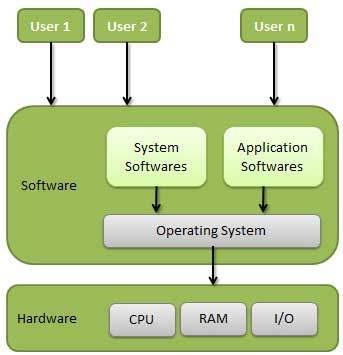An operating system (OS) is a collection of software that manages computer hardware resources and provides common services for computer programs. The operating system is a vital component of the system software in a computer system. This tutorial will take you through step by step approach while learning Operating System concepts.An Operating System (OS) is an interface between a computer user and computer hardware. An operating system is a software which performs all the basic tasks like file management, memory management, process management, handling input and output, and controlling peripheral devices such as disk drives and printers.Some popular Operating Systems include Linux Operating System, Windows Operating System, VMS, OS/400, AIX, z/OS, etc.
Definition
An operating system is a program that acts as an interface between the user and the computer hardware and controls the execution of all kinds of programs.

Following are some of important functions of an operating System.
(1)Memory Management
(2)Processor Management
(3)Device Management
(4)File Management
(5)Security
(6)Control Over System Performance
(7)Job Accounting
(8)Error Detecting Aids
(9)Coordination Between Other Software and Users
The problems with Batch Systems are as follows −
(1)Lack of interaction between the user and the job.
(2)CPU is often idle,because the speed of the mechanical I/O devices is slower than the CPU.
(3)Difficult to provide the desired priority.
Definition
An operating system is a program that acts as an interface between the user and the computer hardware and controls the execution of all kinds of programs.

Following are some of important functions of an operating System.
(1)Memory Management
(2)Processor Management
(3)Device Management
(4)File Management
(5)Security
(6)Control Over System Performance
(7)Job Accounting
(8)Error Detecting Aids
(9)Coordination Between Other Software and Users
Types of Operating System
Here,We are discussing about type of Operating System and details also.
(1)Batch Operating System
The users of a batch operating system do not interact with the computer directly. Each user prepares his job on an off-line device like punch cards and submits it to the computer operator. To speed up processing, jobs with similar needs are batched together and run as a group. The programmers leave their programs with the operator and the operator then sorts the programs with similar requirements into batches.
The problems with Batch Systems are as follows −
(1)Lack of interaction between the user and the job.
(2)CPU is often idle,because the speed of the mechanical I/O devices is slower than the CPU.
(3)Difficult to provide the desired priority.
(2)Time-Sharing Operating Systems
Time-sharing is a technique which enables many people, located at various terminals, to use a particular computer system at the same time. Time-sharing or multitasking is a logical extension of multiprogramming. Processor's time which is shared among multiple users simultaneously is termed as time-sharing.The main difference between Multi programmed Batch Systems and Time-Sharing Systems is that in case of Multi programmed batch systems, the objective is to maximize processor use, whereas in Time-Sharing Systems, the objective is to minimize response time.Multiple jobs are executed by the CPU by switching between them, but the switches occur so frequently. Thus, the user can receive an immediate response. For example, in a transaction processing, the processor executes each user program in a short burst or quantum of computation. That is, if n users are present, then each user can get a time quantum. When the user submits the command, the response time is in few seconds at most.
(3)Distributed Operating System
Distributed systems use multiple central processors to serve multiple real-time applications and multiple users. Data processing jobs are distributed among the processors accordingly.The processors communicate with one another through various communication lines (such as high-speed buses or telephone lines). These are referred as loosely coupled systems or distributed systems. Processors in a distributed system may vary in size and function. These processors are referred as sites, nodes, computers, and so on.
(4)Network Operating System
A Network Operating System runs on a server and provides the server the capability to manage data, users, groups, security, applications, and other networking functions. The primary purpose of the network operating system is to allow shared file and printer access among multiple computers in a network, typically a local area network (LAN), a private network or to other networks.
(5)Real Time operating System
A real-time system is defined as a data processing system in which the time interval required to process and respond to inputs is so small that it controls the environment.The time taken by the system to respond to an input and display of required updated information is termed as the response time.So in this method, the response time is very less as compared to online processing.
There are two types of real-time operating systems.(1)Hard Real-Time Systems(2)Soft Real-Time Systems

No comments:
Post a Comment